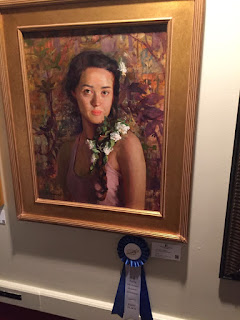"Gordon", oil, 12" x 12"
A quick oil sketch of the wonderful Gordon from a few months ago. "Quick" in this case means one hour. I think that is super-fast, at least for me. They don't always turn out well but I liked this one. He was a calm, patient sitter.
One thing you should know about painting fast like this is that
nobody cares how fast you paint anything. Except your sitter, who probably wants to take a nap or have lunch. (If you're painting in front of an audience, they will also care, and maybe start to fall asleep too.) Sure, somebody might ask you, "How long did it take you to do that?" You should answer as Picasso did: "It took all my life". But the answer doesn't really matter when you see a painting on the wall. You either like it, or you don't, right?
I'm going to be giving a short demo next week for a local art group, the Scottsdale Artists League, in Scottsdale, Arizona, so painting alla prima oil sketches has been on my mind.
Many times you run into sitters who simply can't hold still, or don't have much time for the sitting, for one reason or another. If you have ever sat as a model you'll know that it isn't easy, isn't all that much fun and artists can really be annoying. You could draw or sketch people with drawing media, of course, which could be faster, but the real reason to paint a person in a limited amount of time is because of the joy of the process of doing it and it gets addictive, I think.
"Whitney", oil, 12" x 9"
Whitney has a wonderfully animated, lively face. She talked as I painted, something I don't usually let models do, but it was so interesting to watch her expressions change as I painted. We were by ourselves in my studio so it all was relaxed and fun.
If you have only a limited amount of time to paint something and you want to do a decent job, there are some things you can do to make things go a little bit easier.
First, a few thoughts.
1. You can do a bad painting quickly. You can also do a bad painting while taking a long time. I've done bad paintings both ways. (You can do a big bad painting or a small bad painting, by the way; the small ones are a little less painful.) Nobody really cares how long it takes to do a painting,
it just matters if it's good. Having said that: I believe that process matters. It matters! Artists discuss this from time to time and by that I mean they argue about it. This deserves its own blogpost, one of these days.
2. It takes a long time to learn how to paint a good portrait quickly. You need to know how to draw well before you can learn to paint well. A lot of mistakes are drawing and value errors, not color mistakes. There are also paint-mixing considerations which can be overwhelming.
3. Practice on a lot of still life setups at the same time you're painting heads from life. The still life paintings will improve your head studies, and vice versa. Work on accuracy.
4. It can be hard to get models, especially those who don't move around and fidget. Friends and relatives can be tricky. Paint yourself over and over again if you have to. If you've done this for a while, as I have, you'll get to enjoy watching yourself age over the years.
Oh, great. I like painting other artists because then you take turns sitting for each other and learn a lot about the other artist's working methods, too.
By the way, this alla prima method isn't necessarily my own preferred way to paint a person - I like to take my time and paint directly over a series of days, which is I think technically not alla prima (which means, one shot) but is still considered "direct painting". I guess I'll blog about that sometime also.
So: in addition to the above advice, are there other things an artist can do to stand a better chance of painting a good, fast alla prima portrait? More to come in Part Two.












